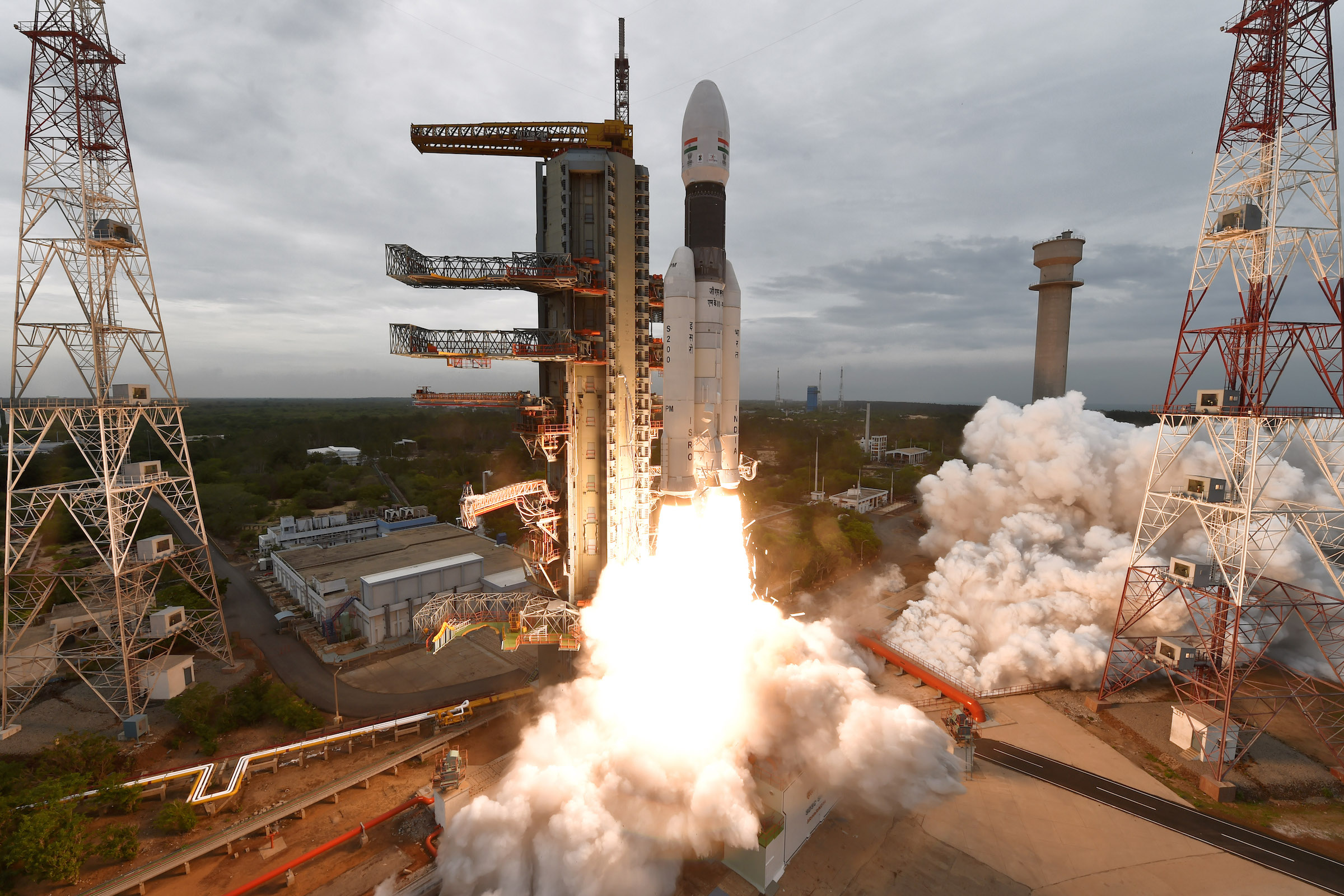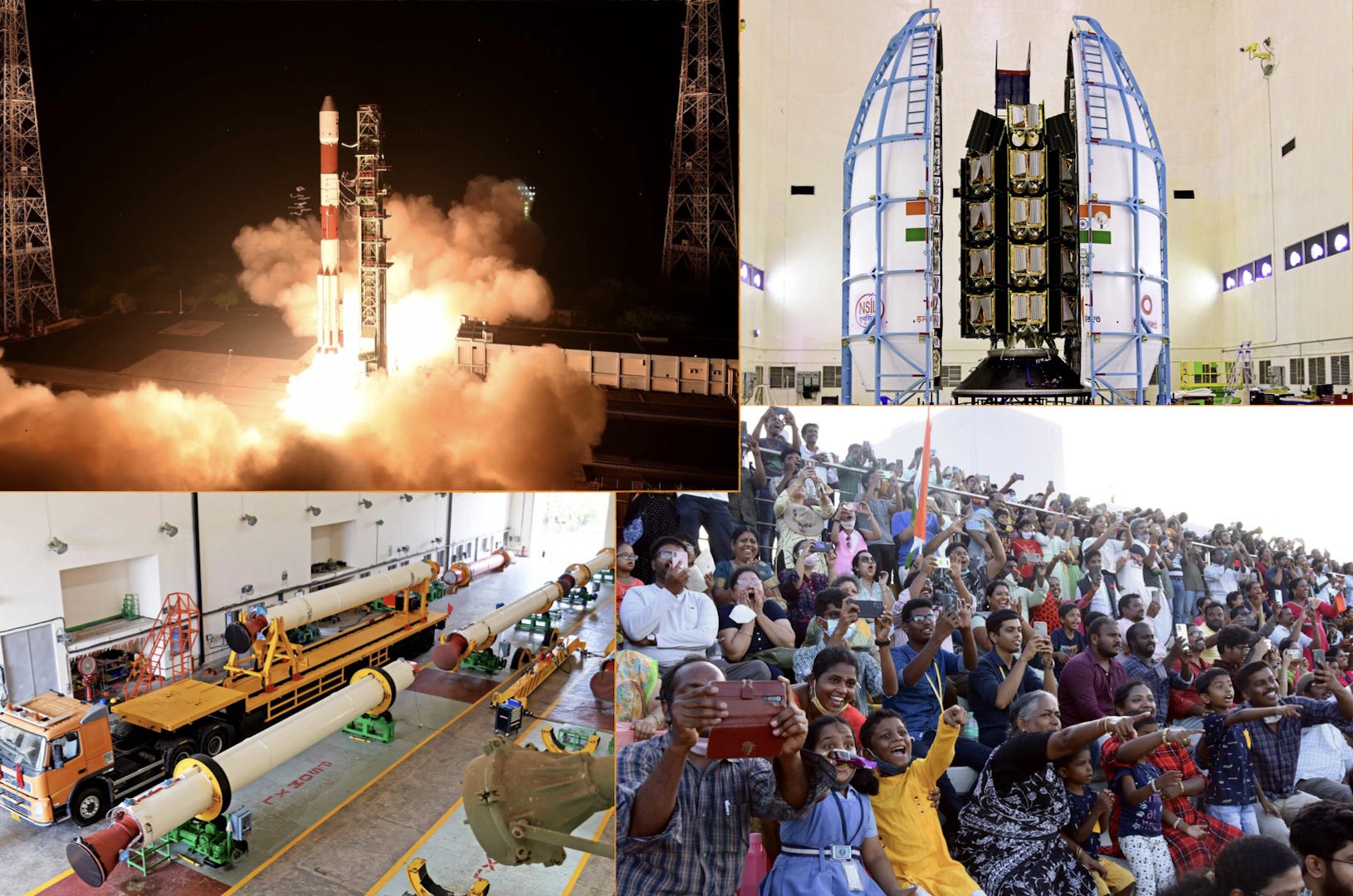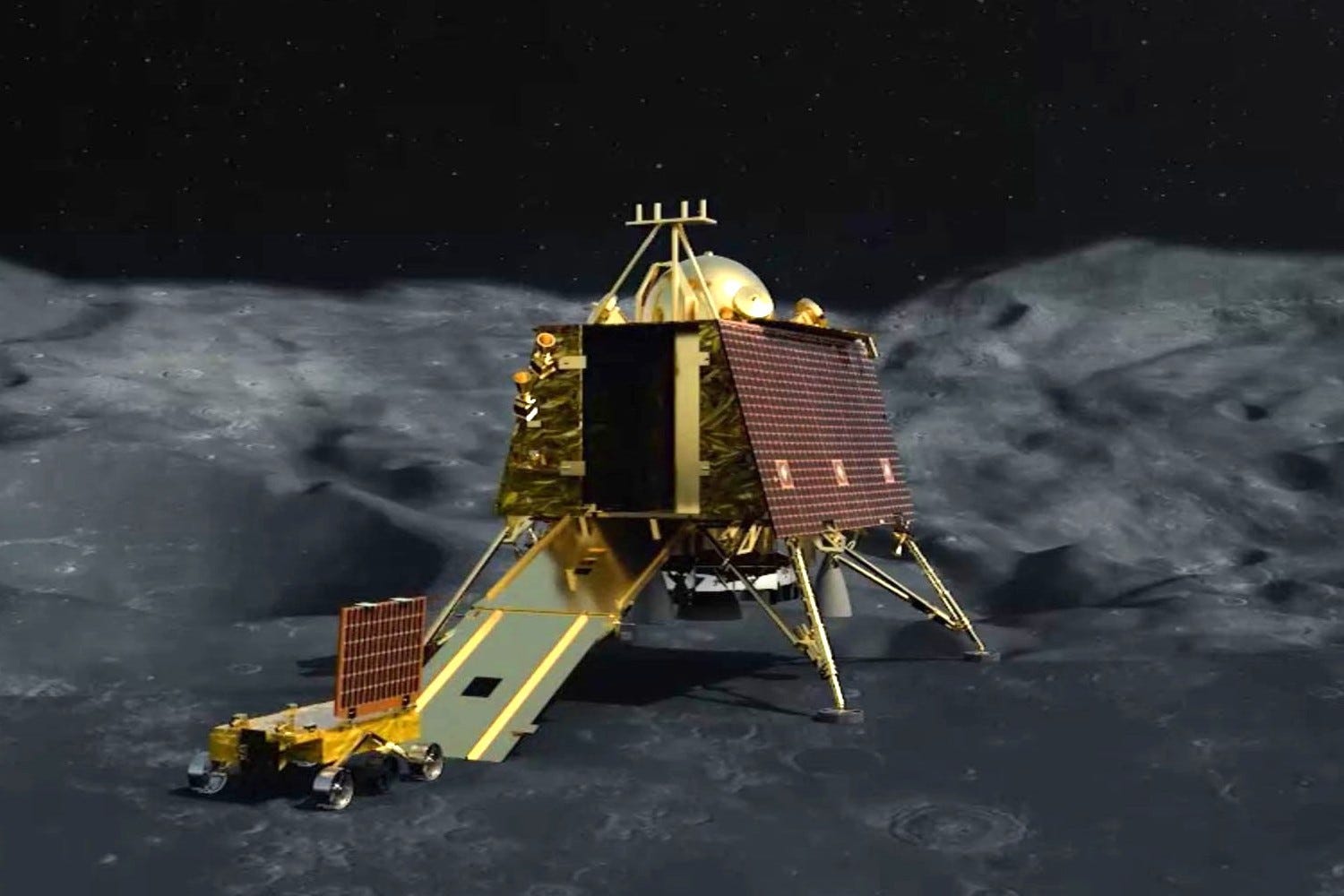Indian Space Progress #1: Looking back at 2022 and forward to 2023
Introducing the world’s only newsletter dedicated to covering all of Indian space.

Welcome to the first edition of Indian Space Progress, the world’s only newsletter dedicated to covering the entire (civil) Indian space landscape—from space technology, launch & exploration to astrophysics & planetary science to commercial & policy developments and more. To be published monthly by me, Jatan Mehta, on this space blog of mine, the newsletter aims to track the progress—or lack thereof—of all major pieces driving India’s increasingly relevant space capabilities in the global arena. To that end, the newsletter’s name abbreviates to ISP, which should give rocket science enthusiasts a good chuckle while metaphorically representing said purpose. I have two key motivations to launch this newsletter:
- There’s a lot happening lately in Indian space, and increasingly so, but both availability of relevant information and access to it remain scattered, fragmented, and opaque. As such, my baseline goal with the newsletter is to consolidate everything in one place for convenience, with tons of links of course, and get a sense of the bigger picture. Ideally, I wish to provide valuable analysis and commentary up top. If you’re familiar with my flagship Moon Monday newsletter, Indian Space Progress aims to deliver similar value, except monthly.
- I genuinely believe my country has a key role to play in space this century, especially from the perspective of being Earth’s largest democracy and a somewhat geopolitically neutral nation. I hope India can help shape global polices for sustainable, cooperative, and peaceful space exploration. However, ensuring that is the duty of its own citizens, and that’s why I wish to contribute a tiny bit by expanding my writings on Indian space with this newsletter.
For this inaugural Indian Space Progress edition, I’m starting with a review of all major Indian space activities from last year so it’s easy to feed forward that context for the next editions, all of which will be monthly reviews.
Before we begin, I’d like to gladly acknowledge and thank The Takshashila institution for being the first and enabling sponsor of the Indian Space Progress newsletter!
Takshashila is an independent center for research and education in public policy based out of Bengaluru, India. Among its many areas of work as a non-partisan, non-profit organization, Takshashila tracks outer space affairs, especially as they pertain to India, and provides regular inputs to policymakers and the public at large. Personally, I’m inspired by the fact that the organization’s work on space played a low-key, background but instrumental role in liberalizing India’s space policy.
Related note for my readers: I have published a more formal Editorial Independence Policy to transparently convey the specific ways in which I ensure editorial independence of my space writings as well as the exact way I run sponsorships.
2022 was a bittersweet year for the Indian Space Research Organization (ISRO) as well as the country’s space ecosystem at large. While ISRO launched its own rockets only five times, one of them was a globally recognized commercial loft of OneWeb satellites to orbit. The agency made substantial progress in technology testing for a future crewed mission but its planetary and space science endeavors took big hits. The new ISRO Chief is thankfully more candid and available than the last one but the agency as whole remains characteristically opaque in its communications. ISRO continued advances in realizing several core space technologies but private space capabilities, aimed to be catalyzed by commercial reforms, are still brewing. Let’s unpack it all.
ISRO’s launches in 2022

On February 14, 2022, ISRO’s PSLV-XL rocket launched the 1710-kilogram EOS-04 radar imaging satellite into its intended sun-synchronous polar Earth orbit at 529-kilometer altitude. The rocket also deployed INSPIRESAT-1, an ionosphere-studying satellite jointly built by India, the U.S., Taiwan, and Singapore.
On June 22, a European Ariane 5 rocket launched GSAT-24, an ISRO-made $48 million communications satellite funded, owned, and operated by New Space India Limited (NSIL), a relatively new Department of Space (DOS) company tasked with undertaking end-to-end commercial activities for India, including wholly operating satellites. To that end, NSIL leased GSAT-24’s entire capacity to Tata Play for the latter’s Direct-to-Home consumer business.
Another NSIL launch followed shortly on June 30, with India’s workhorse PSLV lofting 3 distinct Singapore-made satellites to low Earth orbit. Dhruva Space, a private company based out of Hyderabad, successfully tested their satellite deployment system onboard this PSLV’s spent fourth stage POEM, which is a unique ISRO-provided stabilized orbital platform apt for post-mission technology demonstrations.
The August 7 debut flight of the SSLV rocket—which once operational is supposed to provide “launch on demand” capability for sub-500-kilogram payloads—unfortunately failed. The rocket was carrying an ISRO-made infrared Earth observation satellite and a privately developed small satellite. SSLV’s fourth and final stage failed to attain a circular 356-kilometer orbit due to a lingering anomaly from the second stage separation. The final stage and satellites onboard were ultimately destroyed upon atmospheric reentry. ISRO is targeting SSLV’s second launch in late February.
On October 23, space enthusiasts around the world cheered as a GSLV Mk III, ISRO’s most powerful rocket, successfully launched and deployed 36 of OneWeb’s internet-providing 150-kilogram satellites into a 600-kilometer circular low Earth orbit. The next such batch of OneWeb satellites were delivered to India late January, and are being prepared for launch in March.
Lastly, on November 26, a PSLV-XL successfully launched and deployed the ocean-studying EOS-06 satellite, an advanced replacement of ISRO’s 2009-launched Oceansat-2. The rocket also lofted 8 nano-satellites, comprising four CubeSats from US-based Spaceflight Inc, two of Dhruva Space’s sub-1-kilogram Thybolt technology demonstrators, Pixxel Space’s Anand hyperspectral imaging nano-satellite, and Bhutan’s first satellite INS-2B (developed in collaboration with India).
Space science progress, or lack of it

At the start of 2022, ISRO seemed set to launch during the year at least a couple of its upcoming space science missions: a reattempt of the prestigious Moon landing prize with Chandrayaan 3, and the versatile Aditya-L1 observatory to study the Sun’s surface, atmosphere, and its wind.
As things turned out, the Chandrayaan 3 lander has been robbed of its ride to space, twice, as ISRO prioritized two GSLV Mk IIIs for commercial OneWeb launches. Since India produces a Mk III roughly once every 8 months, the wait to see the lander blast off to our Moon will be at least until end of year. On the other hand, Aditya-L1 received its key coronagraph instrument only this January, and so is now being targeted for launch no earlier than Q2 2023.
In contrast, when India’s first Mars orbiter Mangalyaan reached end of life in April 2022 as a highly successful technology demonstration mission, ISRO went on to also label it a “scientific feat in the history of planetary exploration”. But the truth of the matter is Mangalyaan has a huge vacuum of scientific results simply because it was never designed to be a science mission. Forcibly calling Mangalyaan more than what it was isn’t just wrong but dangerous since it conditions a large population to have subpar expectations of scientific progress from future missions.
India’s space science successes can be found in AstroSat, the country’s first dedicated multi-wavelength space telescope that completed 7 years in Earth orbit in September 2022 and whose data has led to more than 150 cited works in reputed international journals. While AstroSat doesn’t get the same limelight as Mangalyaan, Ritesh Singh nevertheless celebrates the mission’s successes with a nice journal article in the Oxford University Press.
Much the same can be said for India’s Chandrayaan 2 orbiter, whose data has continued to generate significant new scientific results, from creating the first ever global-scale sodium maps of our Moon to uniquely characterizing plasma in the lunar exosphere, and even uniquely studying our Sun!
Gaganyaan, preparing for India’s Yuri Gagarin moment

With the ambitious Gaganyaan mission, India aims to be the world’s fourth nation to indigenously send humans to space, following Russia, the U.S., and China. The first crewed demonstration flight of Gaganyaan will send 3 astronauts to a 400-kilometer low Earth orbit for 3 days and bring them back home safely.
Despite roadblocks and delayed funding, ISRO inched towards some baseline technologies necessary to even plan such a massive feat for well over a decade before the Indian government formally green-lit the country’s human spaceflight program in 2018. Progress on technological components has been faster ever since, with 2022 doubling down on that with a successful test of the crew capsule’s abort system and an integrated parachute test demonstrating safe capsule splashdown in the event one of the three main chutes fail to open. ISRO also advanced further in qualifying the liquid-fueled Vikas core stage engine and the third stage cryogenic engine for the human-rated variant of the GSLV Mk III rocket.
ISRO is planning to conduct two abort tests this year, one by May and the other by August, followed by a uncrewed Gaganyaan flight. If all goes well, a repeat set of these test missions will follow next year, after which the first astronauts will launch from Indian soil. 👩🏽🚀
Technology building
Last year ISRO continued building core space technologies with a good pace. In January 2022, DOS researchers demonstrated secure quantum-entanglement-based communications over 300 meters, with the ultimate aim being to demonstrate the same on satellites.
In September, India opened up in Bengaluru a dedicated facility for manufacturing cryogenic engines. ISRO’s work on hybrid rocket motors continued to scale up in 2022, with the intention being to use them in future, more powerful launch vehicles. Relatedly, a key test ISRO will conduct this year is the first landing demonstration of its Reusable Launch Vehicle spaceplane prototype.
On December 8, ISRO successfully conducted the first blow-down test in its newly inaugurated Trisonic Wind Tunnel, which can simulate flight conditions from 0.2 times to 4 times the speed of sound. This will help India adequately test atmospheric re-entires of future, large reusable spacecraft and rockets with subscale analogs.
Commercial and private space, policy reforms and more

While ISRO’s 2022 launch of OneWeb satellites was the country’s commercial space highlight of the year, many long-term significant developments also took place.
Other than its aforementioned launches, NSIL continued to grow in 2022. In June, India’s Union Cabinet approved the transfer of 10 in-orbit communication satellites from the Indian government to NSIL so as to catalyze their commercialization. Also tasked with commercializing India’s launch vehicles, NSIL awarded a $104 million contract in September to a consortium led by major PSLV contractors HAL and L&T. The goal is to have fully industry-built PSLVs starting 2025 to better commercialize India’s workhorse rocket.
On November 18, Skyroot launched test mission Prarambh, which made it India’s first privately developed rocket to go suborbital. The company aims for an orbital launch sometime later this year. Its competitor Agnikul itself made substantial progress in 2022, including a hot-fire test of its semi-cryogenic 3D-printed engine to work towards a suborbital launch of their Agnibaan rocket sometime this year.
On the satellite front, long-time ISRO contractor Ananth Technologies opened India’s largest private spacecraft manufacturing facility in Bengaluru in mid-2022, which can simultaneously assemble, integrate and test 4 large satellites. Pixxel Space, which raised $25 million in March 2022, says it will launch 6 commercial hyperspectral imaging satellites this year in a sun-synchronous 550-kilometer orbit.
Just yesterday, the Indian government released the country’s FY 2023–24 budget, which starts from April, and it looks bleak for space, with a $133 million cut for space technology building and roughly $8 million cut for space sciences than last year. I’ve attached the DOS budget document below for your perusal.

Indian Space Budget FY 2023–242.93MB ∙ PDF fileDownloadDownload
In all, India’s sprawling space capabilities seem to be on promising trajectories in some areas but not so much in some others. Here’s hoping for more progress.
Do you like my new project to continually provide a comprehensive overview of progress across the entire (civil) Indian space landscape? If so, please consider sponsoring my writings:
→ Browse the Blog | About
